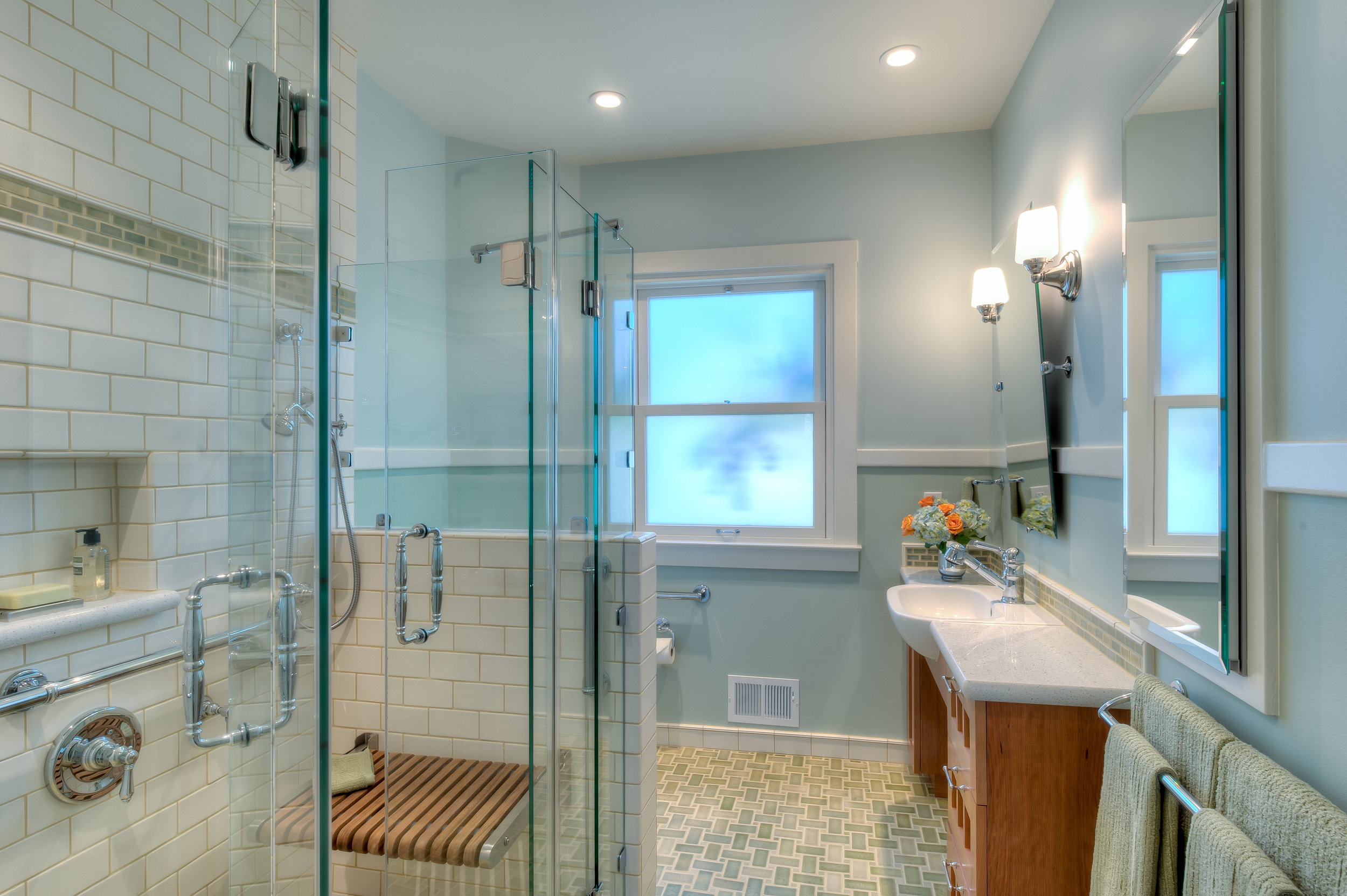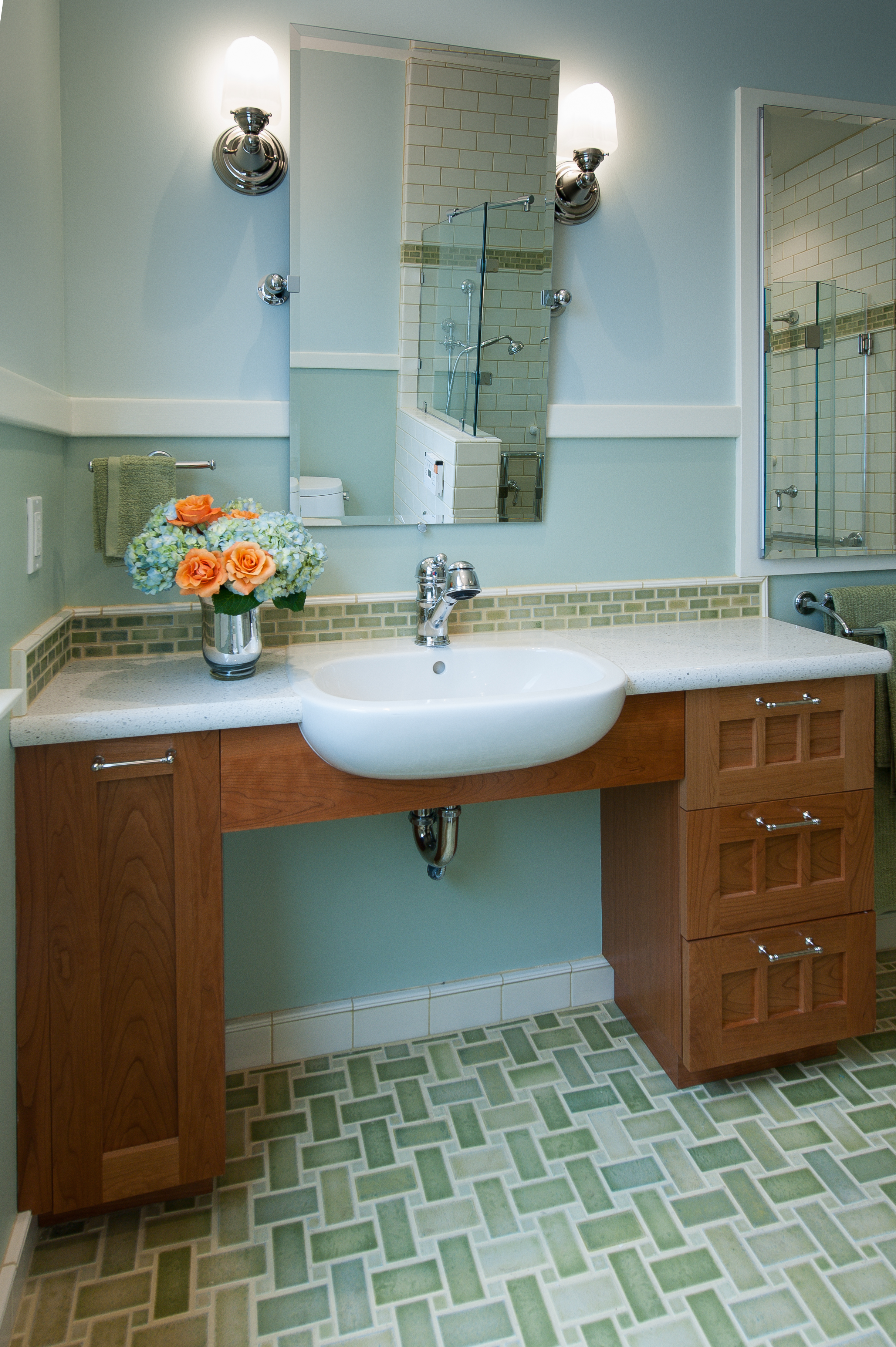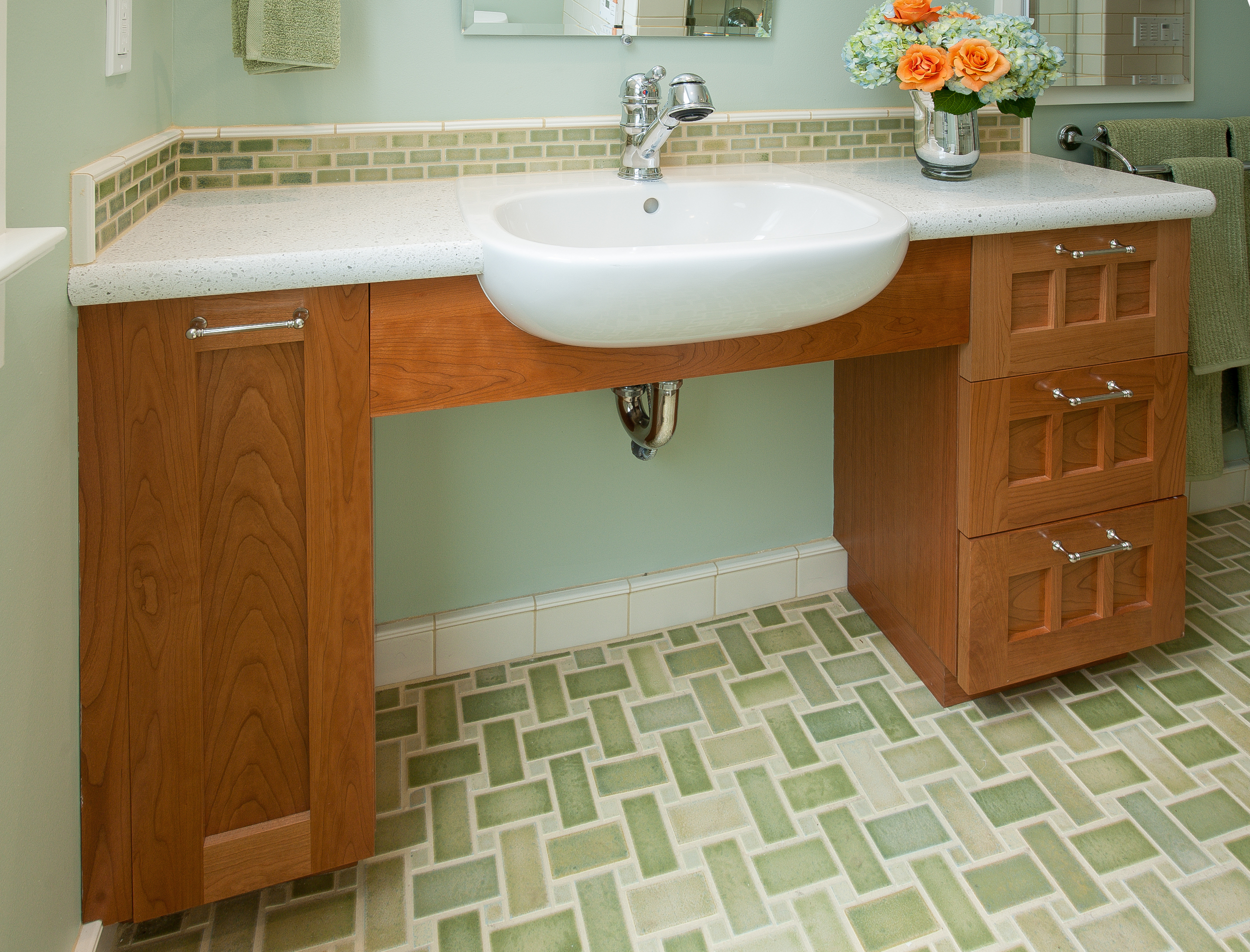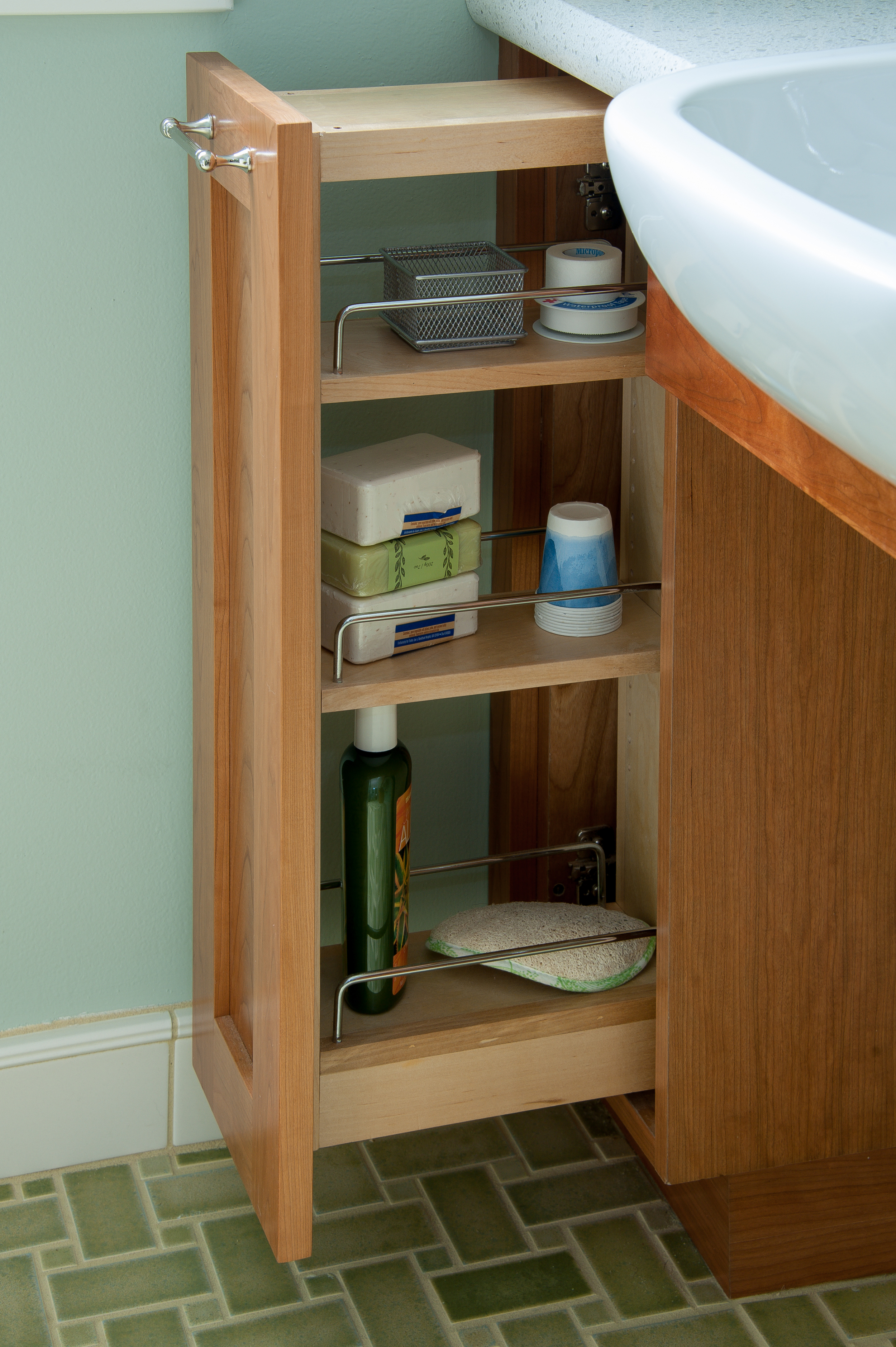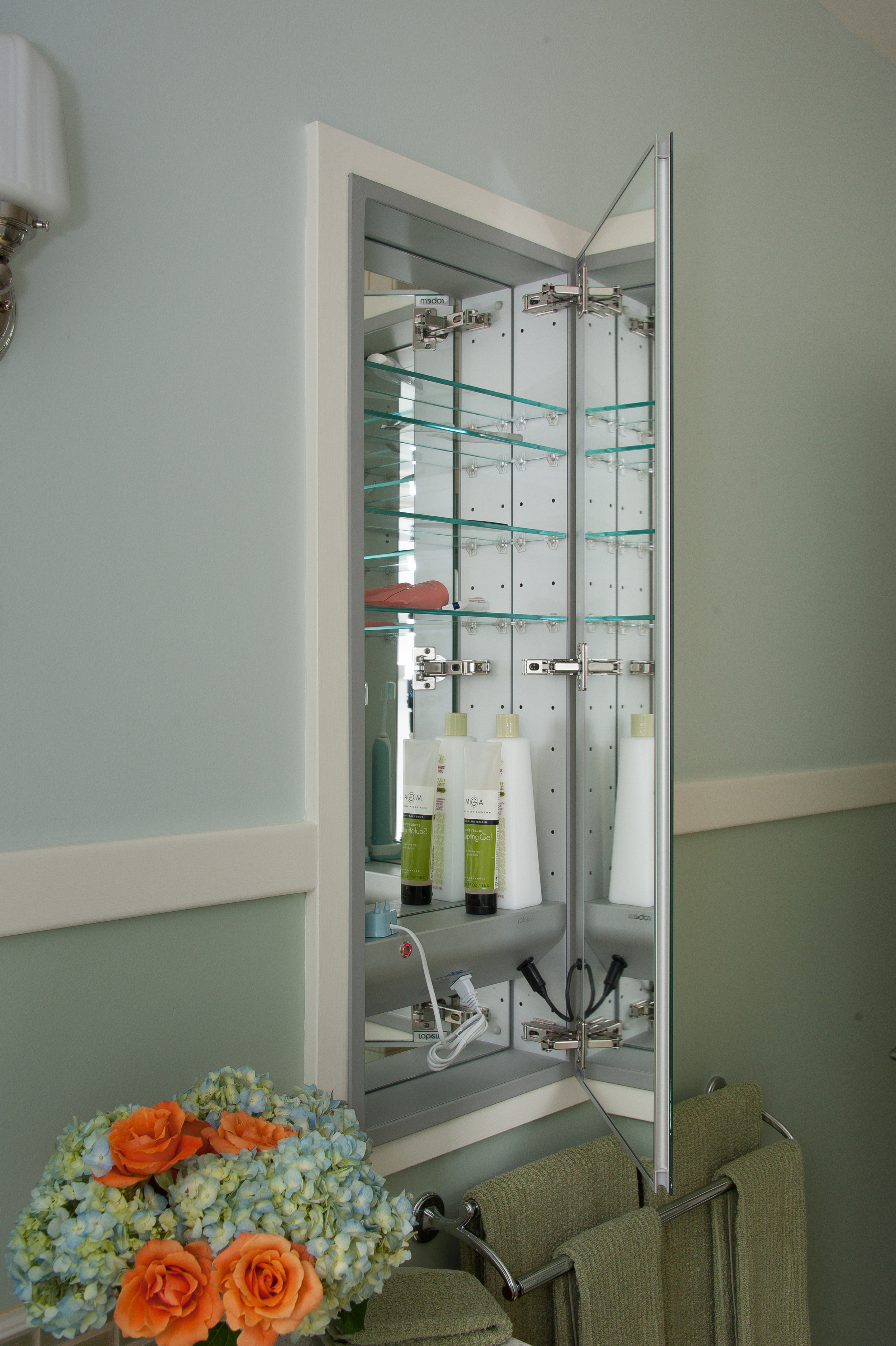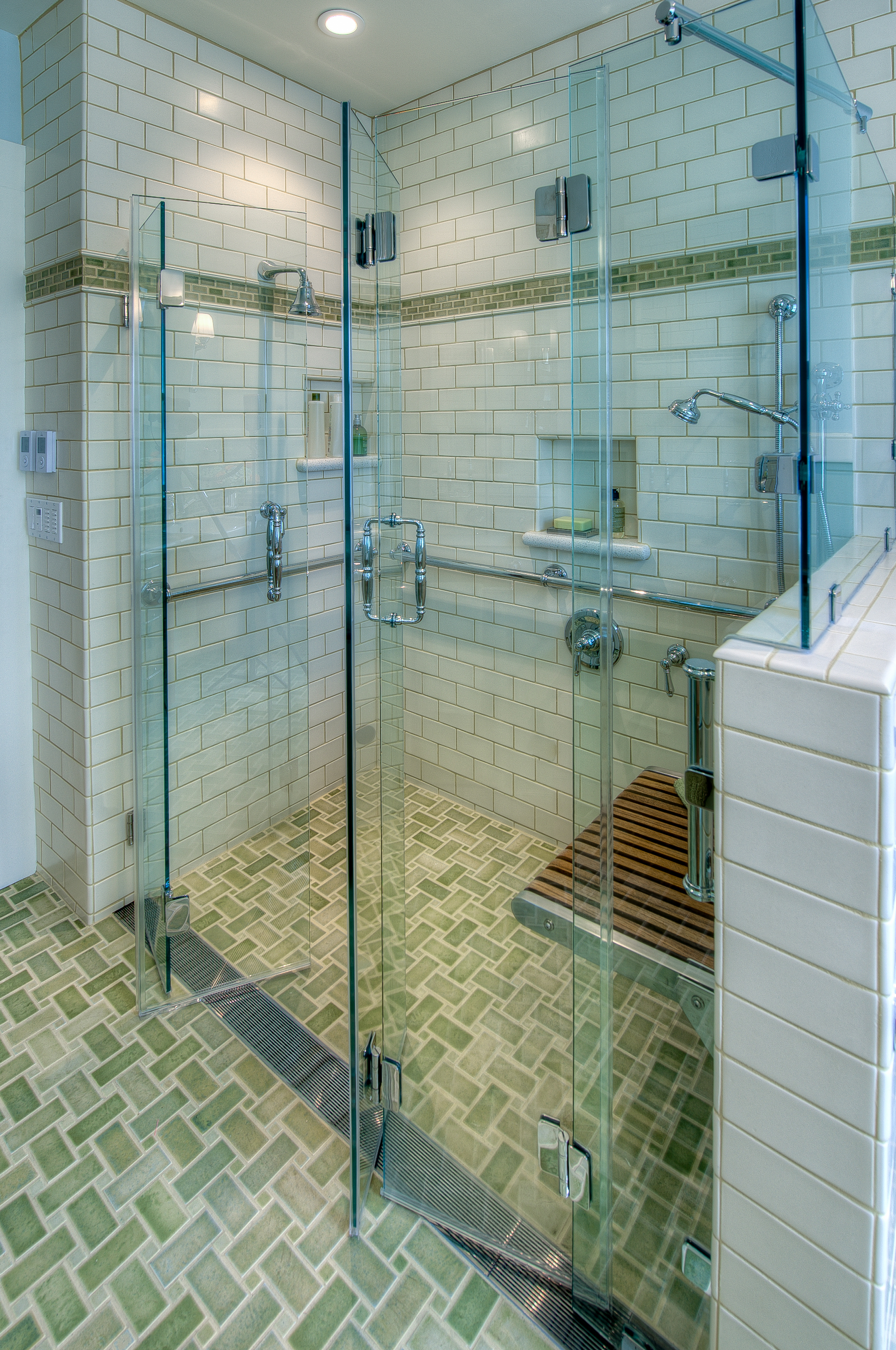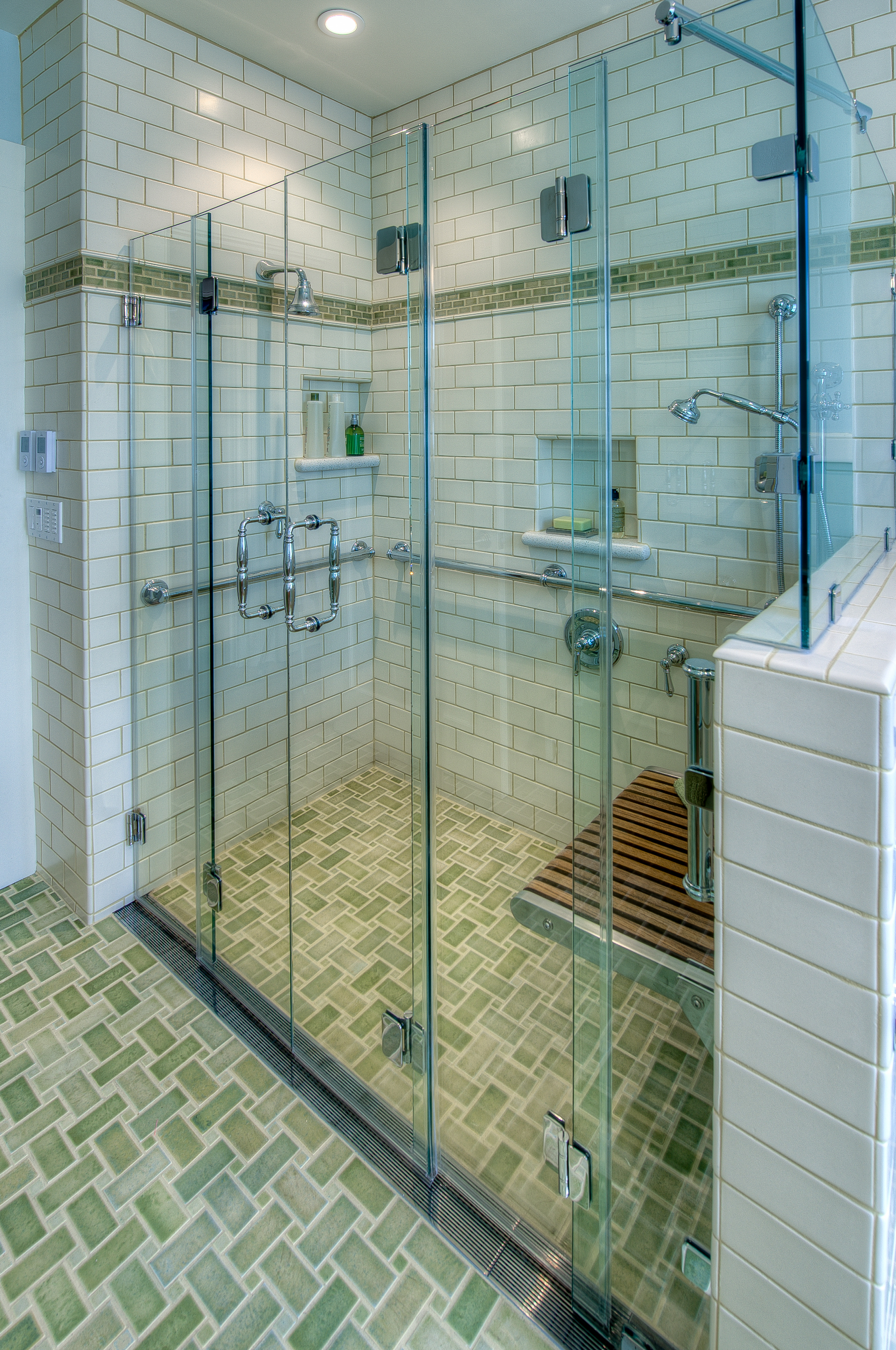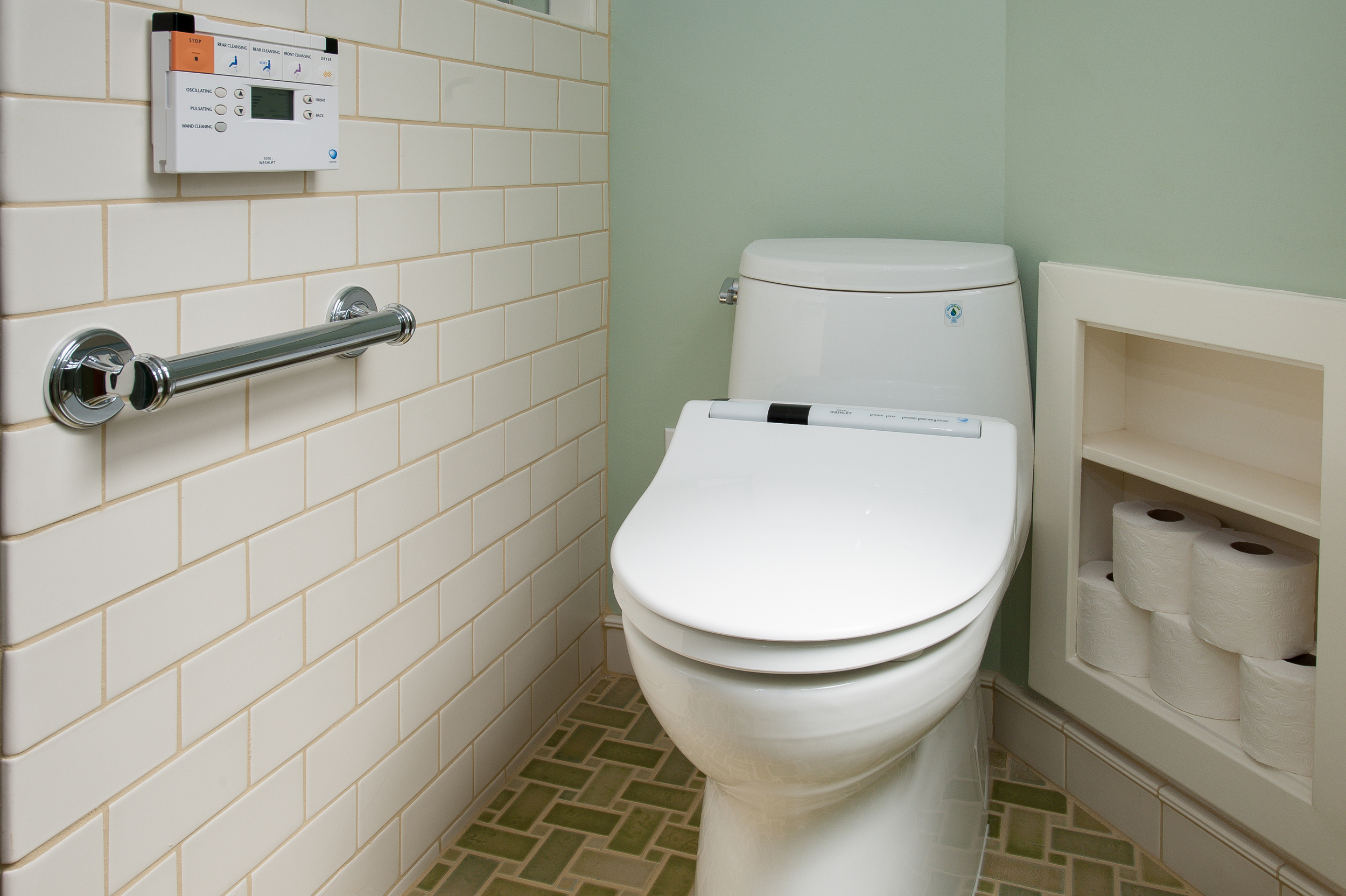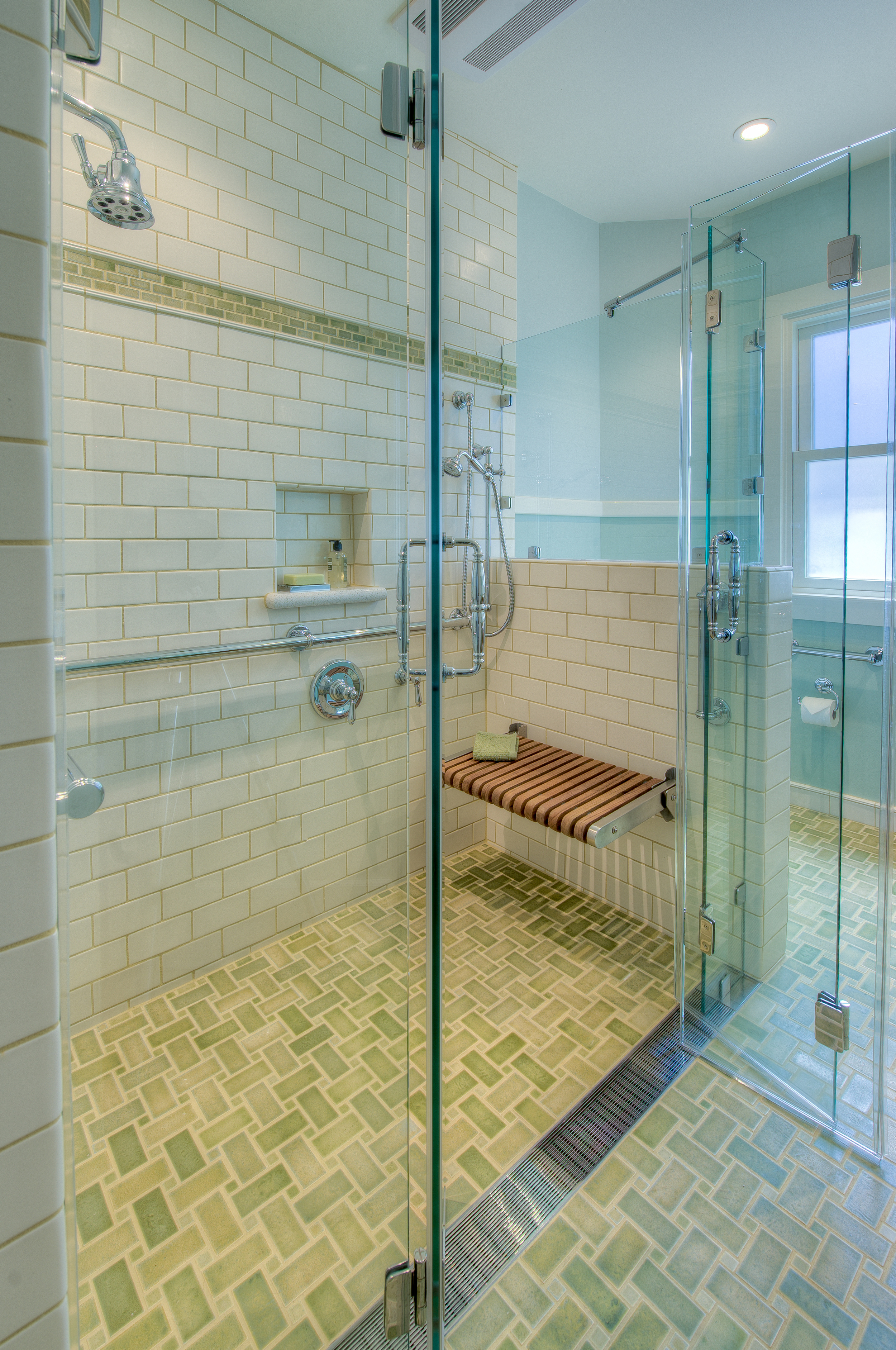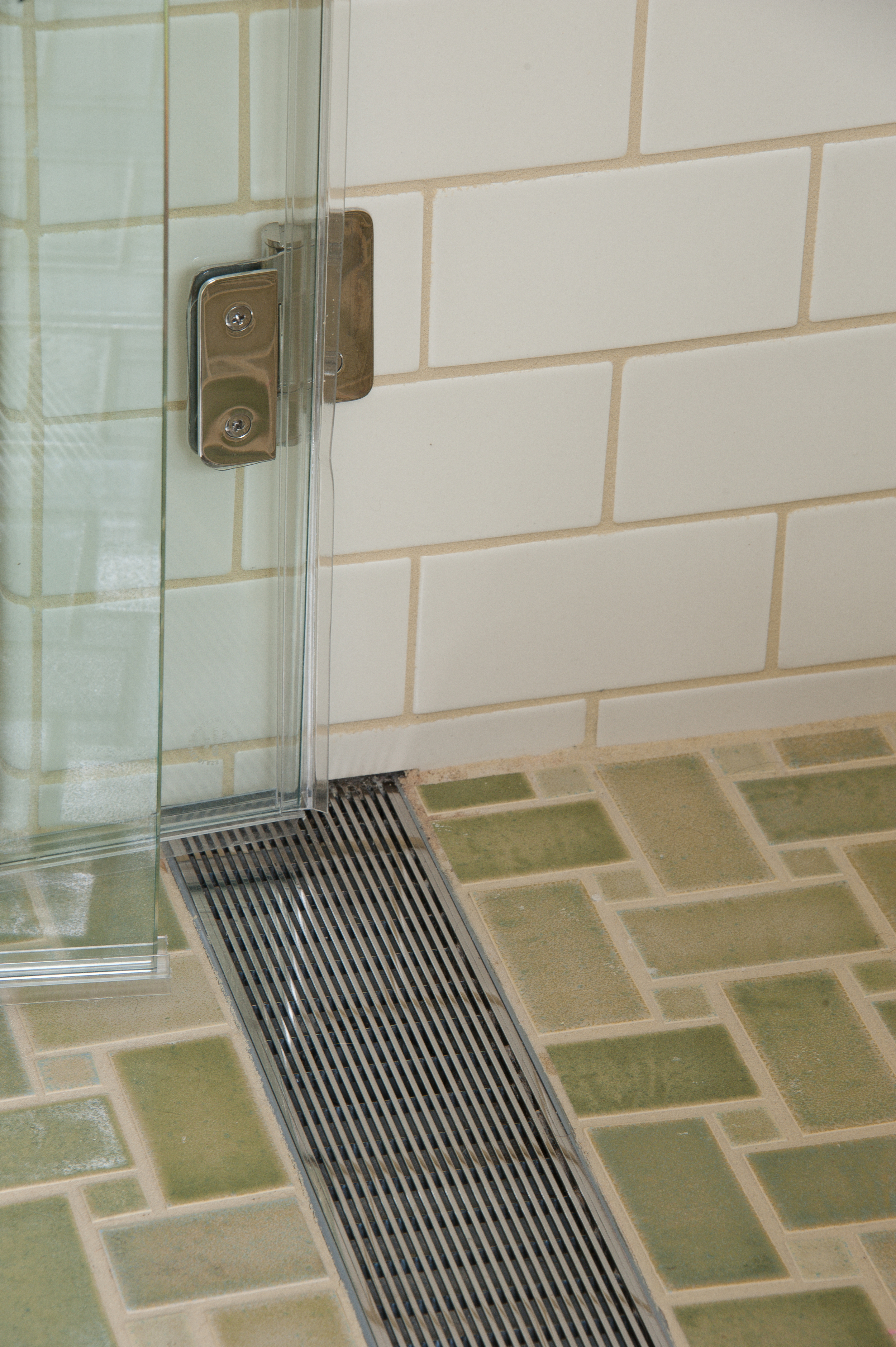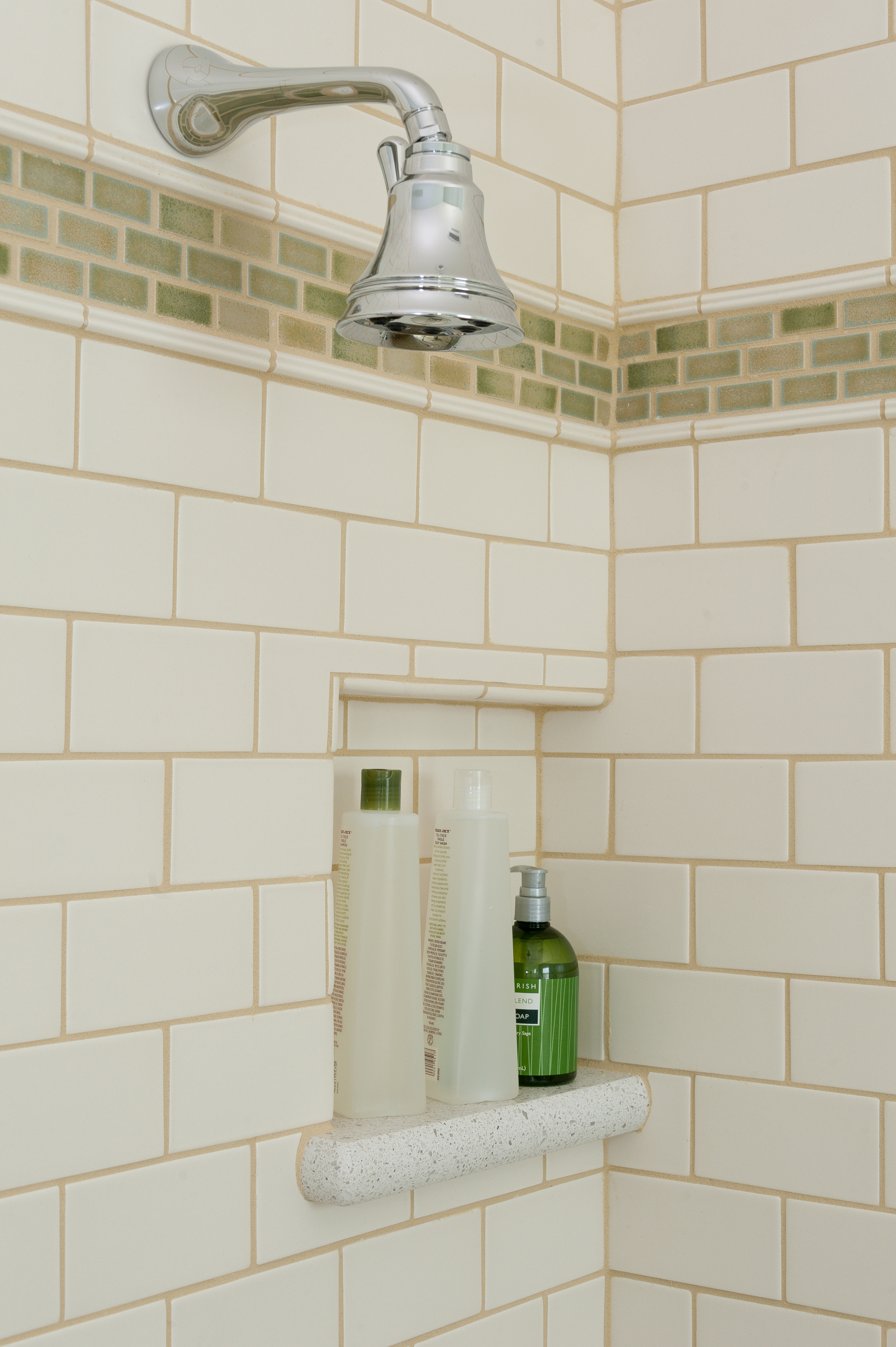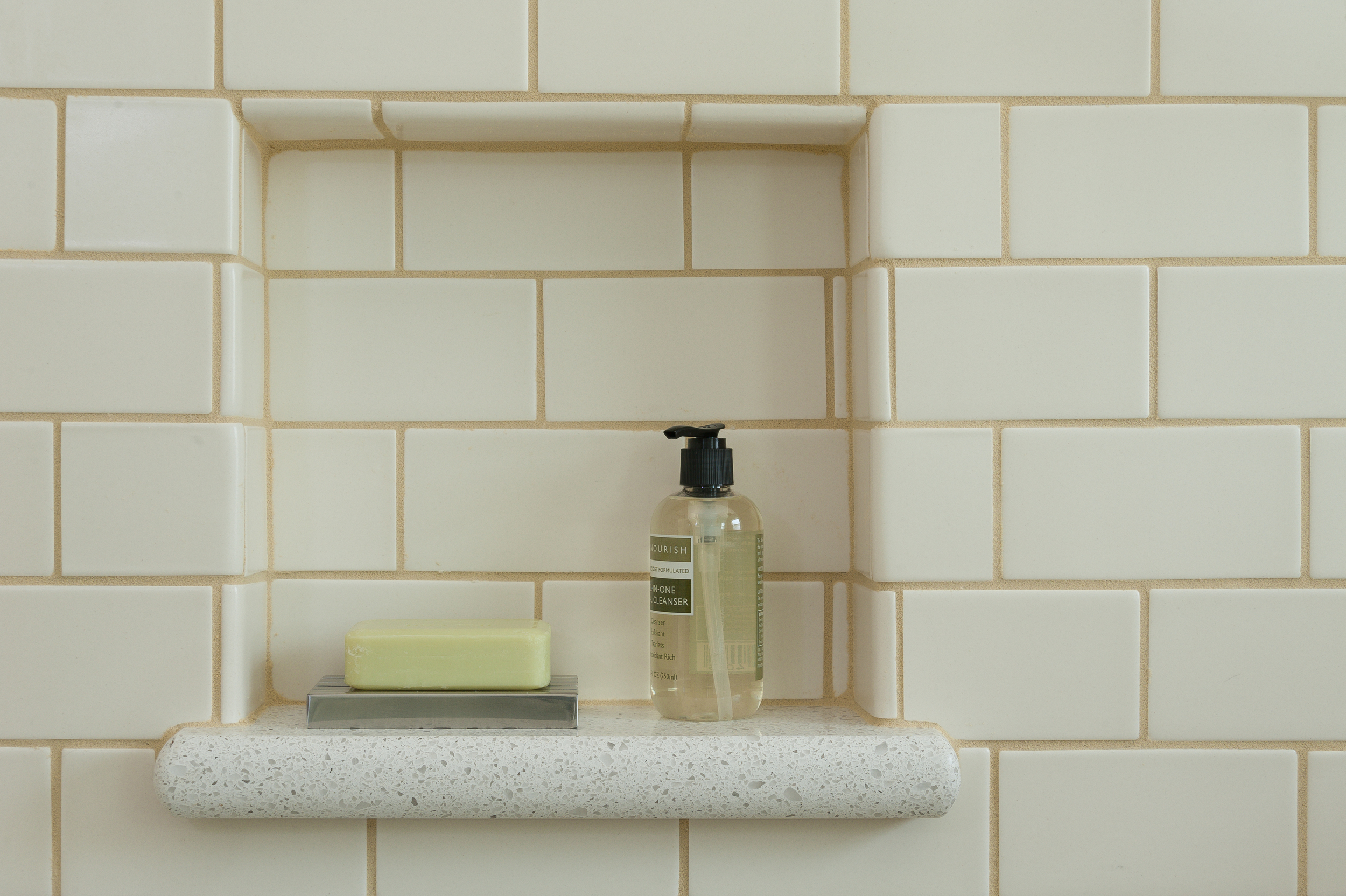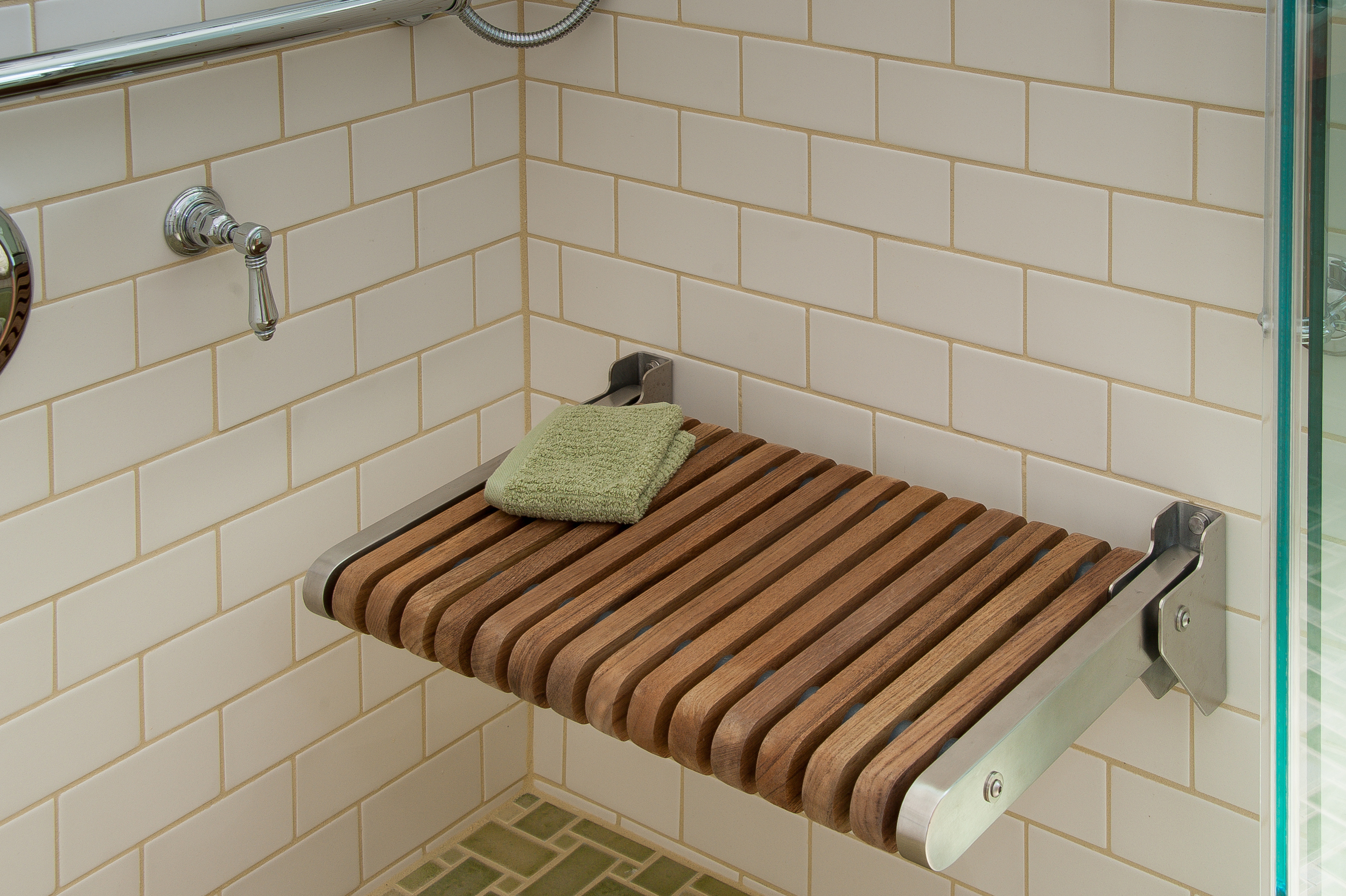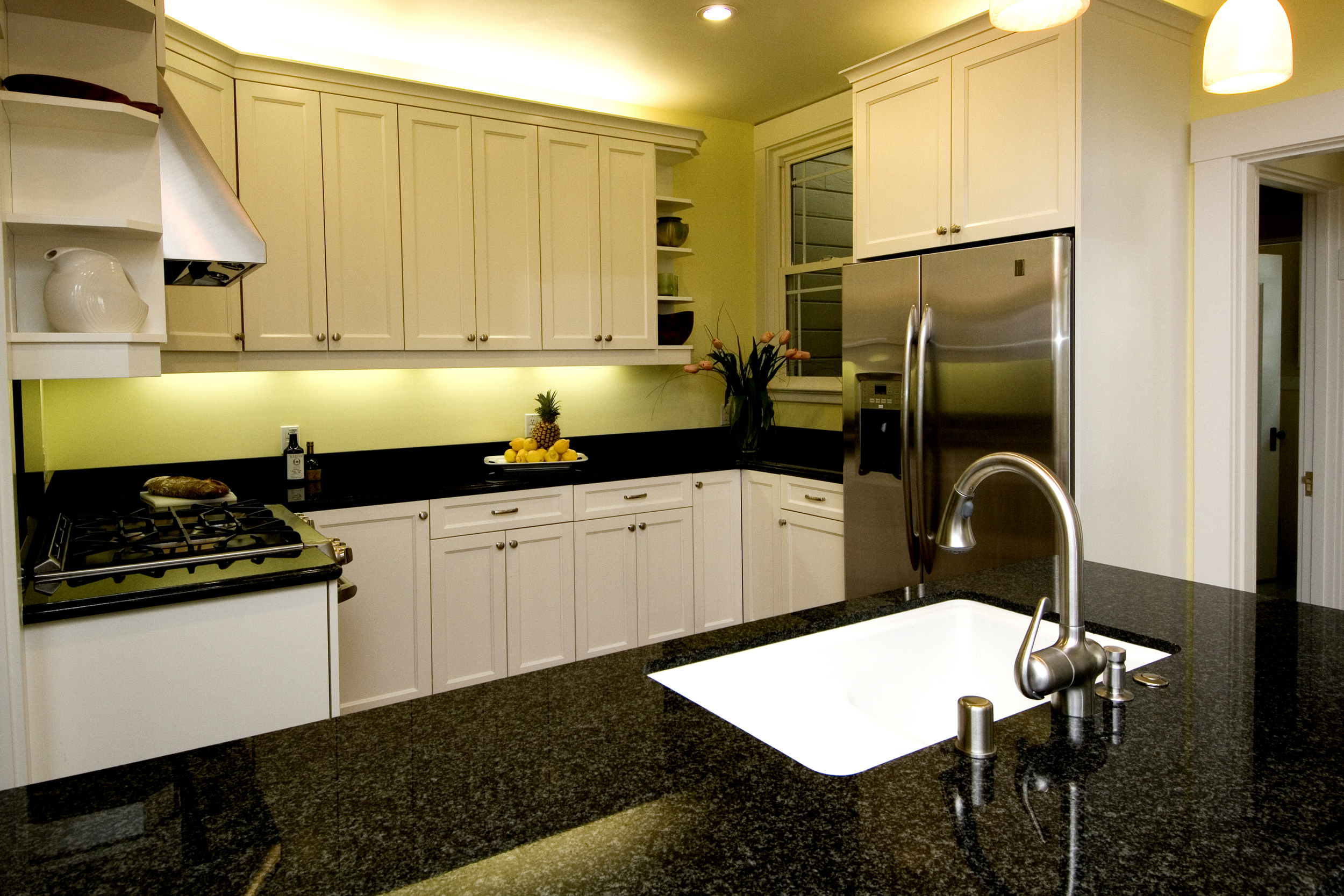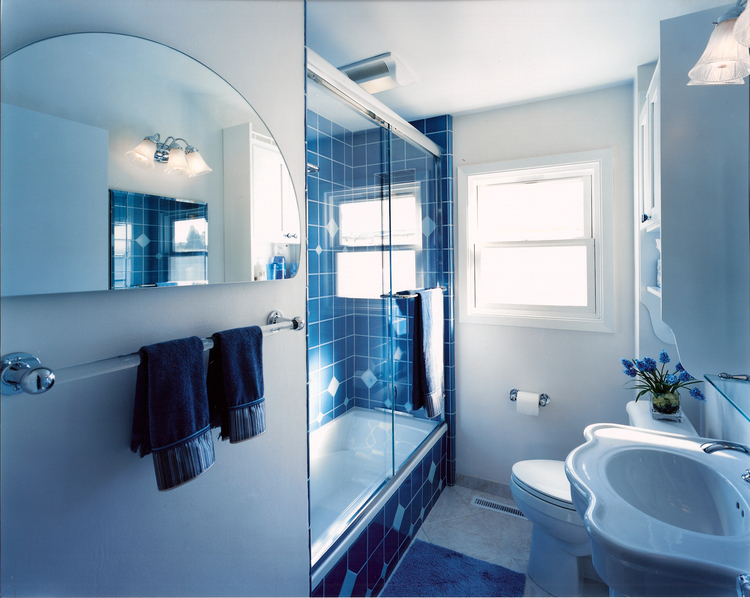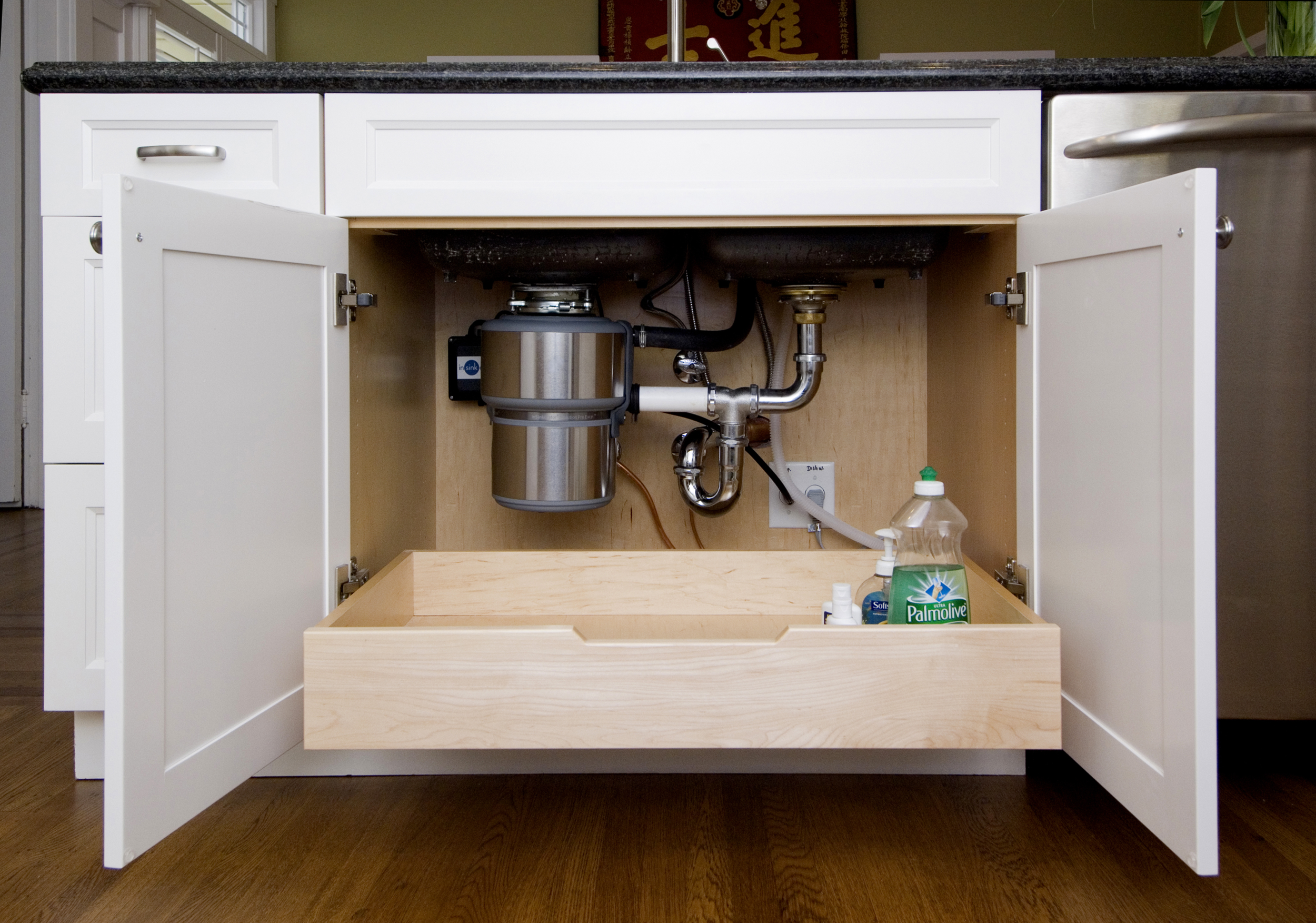When we embarked on the home buying process I initially thought the 1st floor rental unit was legal but not up to today’s code standards and needed only minor repairs. During the disclosures process and surface level investigation, we discovered that the Planning Department didn’t agree...
Read MoreA Designer's Thoughts
Design ideas and inspiration, and trouble shooting areas that could affect any remodel and other pertanent thoughts.
Featured Project: Oakland Montclaire Contemporary Guest Bath
Design “risks” are easier to make in a guest bathroom as they are not used in its entirety on a regular basis. By “floating” the vanity cabinet we were able to open the space and light it from below which gives the illusion of expanding the room as the Crossville Porcelain tile continues beyond.
Cabinetry designed with open storage for extra towels, baskets for toilet tissue and a space to sit down for skin care routines is reminiscent of being in a spa, an experience from which everyone leaves refreshed. Cabinet hardware like these 26 Series bar pulls by Sugatsune come in various lengths and can double as hand towels to prevent cluttered walls and dripping across the room.
Often I am asked about designing master bathrooms with vessel sinks which we discuss in detail the pros and cons and how it may not be the best design for everyday use. However, this guest bathroom with the Kohler Bateau vessel sink coupled with the Kohler Stillness wall-mounted faucet on a mirror adds a touch of something special for guests to enjoy.
"Now Everybody is in the Bathroom!"
In my 2 bedroom home this statement is a daily exclamation from my 4 year old daughter.
My daughter encroaches on my privacy with her fingers and her toes, and sometimes our kitty joins in by waving her tail under too!
As a mom of a small child this is not unexpected, you may have seen the images floating across Facebook and Pintrest of a child's hands poking under a bathroom door when their mom or dad is wanting just a little privacy in he bathroom for even two minutes. Unfortunately, I don't believe there is a real practical solution to this world-wide problem other than to wait-it-out and teach them patience until you're an empty nester.
It is also unsurprising as a family living in a small space where everyone is getting up around the same time. Sure, we've learned to work around each other. I take my shower first, my husband gets his coffee and the little one dilly-dallies, looks at books, plays with our kitty or attempts to play Candy Land on her own. But there is inevitably a point in our morning where we just can't not be in each other's space. Daddy is in the shower, the kiddo has finally agreed or has been coherced into having her teeth and hair brushed while I finish doing my routine, and of course as she doesn't want to be left out, Kitty joins us as an additional bathroom rug just as daddy is stepping out from the shower. That's three humans and one kitty in a standing space no bigger than 2.5 x 3 feet!
My morning experience isn't uncommon in the Bay Area. Many homes in Alameda, Berkeley, Oakland, Marin and San Francisco have the same problem, too little bathroom! Surprisingly some larger homes have this as well! Occasionally they may have a powder room to reduce the wait time to use a toilet, but more often than not, single family homes were designed with single bathroom facilities. Unlike older kitchens without space designed for a refrigerator that I've mentioned in a previous article, I have trouble seeing the logic of the architects and builders after the 1906 earthquake. Bathrooms were a common requirement, the day of the outdoor privy and use of a bed pan for a servant to empty out were gone. I'm speculating, but maybe people simply thought they were still a convienience or a nice-to-have rather than a necessity?
This poses two important questions:
- If I only have one bathroom, how do I remodel and maintain my personal hygiene during that time? There are generally 2 solutions for the common problem
- Move out during the construction time by renting a second home or apartment, going on vacation or staying with family. While this is ideal to keep you from breathing construction dust it is typically unrealistic to many new and retired homeowners financially speaking.
- Live in your home during construction. While living in your home during is the most cost effective, it can increase construction costs when your general contractor needs to uninstall and reinstall a toilet every day so that you're not making nightly trips to a porta-potty. Or you don't have a gym membership or a friend who is generous enough to let you use their shower each day and so your contractor needs to do a little more work to set-up and take-down a temporary shower which takes time away from their duties in completing the remodel a few days or weeks more quickly. Its also easier to be frustraited with daily life in a construction zone, there is dust everywhere even in places where you're not remodeling, if you work from home the noise levels can be so much that you buy a huge pair of noise canceling ear muffs that don't even double as a music headset and most people naturally tend to feel like they need to micro manage the work crews which simply adds to everyone's stress levels.
- How can I add a second bathroom to my home without changing the overall footprint to keep my costs reasonable and not need to go through a long process to get my neighbor's approval?
- In the last few months this has come up and the best solutions have been to absorb another space. Maybe it's a closet, a small office or dressing room or even a second kitchen that was added 30-40 years ago to accommodate student renters near CAL in Berkeley or SF State. Usually the space that needs to be absorbed requires a small sacrifice to get rid of unused items, you may increase your budget slightly to rework a closet in another area for better storage or you simply start to think differently about how you use your home and plan to make changes to your daily routine. Often this question comes up when someone is thinking of selling their home in a year or two. If this is the case its often not worth the stress or expense on your life, leave it to the next buyer. It is better to maintain and upgrade your current bathroom to be appealing than it is to do something with the assumption that someone else will "appreciate" your hardwork.
How many people use your bathroom? What challenges do you have to work around each other? And what would an investment to add another bathroom be worth to your life not just the resale value of your home?
Featured Project: Bungalow Bathroom Gains New Accessibility (This week on Houzz)
When construction and life interact
Planning and preparing to remodel your kitchen and/or bath is a lot of hard work. Even if you hire an interior designer and a construction team there is emotional work, it can often be draining. People I work with often have some vision for their new space, colors, how they might use it and why, more often than not there is much more to be considered.
Last week I met with a couple who's home is in Kensington. It's been their family home for more than 20 years where they raised their family and now have grandchildren come to play. While I was measuring their master bathroom we also discussed how their space might be different, and how might it improve their lives. Would changing from one sink to two make a difference? If we installed medicine cabinets with electrical outlets inside to charge their toothbrushes and other items would they actually use it? We stood together and seriously looked at what is working now... which usually isn't much, so next we looked at what wasn't working and why in an almost Sherlock Holmes methodology. Standing in the space and having some sense of roll play or pretending to use what might be. "Purging" was an option she suggested, but not one that I typically recommend as a starting point. Change is hard and changing the habits we have formed for many years is even harder.
Sometimes we get to the last week before construction is scheduled to start and kitchen cabinets are still full and "no one" has time to pack it away in an organized manner. Often people tell me they will purge when they "move out" of the space, but really how many of us actually do that for everything that needs to go? The last time I moved it was in haste. Our upstairs neighbor had left their bath water running and it over flowed and rained into our apartment. Ideally we would have come back the next day and purged the expired pantry items, household cleaners and junk mail, but instead we purged the major items that were damaged and briskly packed everything including paper trash that really should've been shredded. Whew. When homeowners who are preparing to remodel leave this to the last week it is the same. Maybe there isn't a literal flood to deal with, but the hasty, unorganized packing is stressful and comes back to haunt them when it's time to move into their new kitchen or bath. What a let down to go through all that unwanted stuff in the middle of your new space.
Last year I met a professional organizer, Lis McKinley, from Let's Make Room. She specializes in working with homeowners preparing to remodel. Along with her crew she empties, organizes and assists in cleaning out the stuff that should really be tossed into the trashed and replaced with a better expiration date before unpacking. Earlier this year I introduced her to a couple I was working with in San Francisco to remodel their condo's kitchen and bathroom. While not everyone can or needs to move out, they felt this was the best option for them. Wow, I was impressed! Not only was she providing the needed packing, sorting and general cleaning out but she also helped them to sell unwanted items in good condition, provided and coordinated movers and found them temporary housing! I wish I had known her a couple of years ago!
In the end, whether you decide to do these chores yourself or hire someone who does it all the time, its best to remember that your personal time is valuable. For some it’s time away from your career, and others time with family. Make this time remodeling for yourself about yourself.
Featured Project: San Francisco Inner Sunset Victorian
As an interior designer, having a portfolio of work is important for homeowners to see spaces that they can relate to, compare against and dream about. What's usually missing is the story behind the changes. What was "wrong" with the kitchen or bathroom in the first place? What difference did the changes make? Who was the contractor and other team members involved in the beautiful result? This week I've decided to highlight a San Francisco kitchen remodel that was done a few years ago.
San Francisco is known world wide for her cable cars, steep hills and painted ladies. She and other Bay Area homes are known for their small closets, antique built-ins, formal dining rooms and too many doors connecting small rooms as though they were related to the Winchester Mystery House. This kitchen was no different. Having 5 doors in roughly a 12'x12' space resulted in the refrigerator being located in the breakfast nook (through one of the doors) and the pantry door not opening all the way plus needing to squeeze into a small space just to get to the pantry items.
Why was this kitchen so poorly planned? For starters, refrigeration technology didn't exist. Victorian era people had ice delivered to keep cold items cold for a few days, and here in the Bay Area many used their "California Cooler" which was essentially a dry pantry with circular birdhouse sized holes to allow the foggy cool air regulate temperature. Milk and eggs were delivered regularly and many of the more affluent families had a couple of servants which were to remain hidden from guests while they prepared the food. Our culture has changed significantly from the days of Downton Abbey. Families today who have hired help want open kitchens and are not ashamed of the au pair or the housekeeper who work for them. Why? It's simple, as humans we desire to be connected. Most families are working full time and being together for a few precious hours at home while preparing a meal and doing homework is just what we need.
In redesigning this San Francisco Victorian to be more warm, inviting and useable, the first thing that needed to change was to eliminate a few doors. This was achieved by removing the pantry closet and a duplicate door to the powder room, voila, a place for the refrigerator in the kitchen! The pantry storage was incorporated into cabinetry with easily accessible pullout shelves, lazy Suzan's and other kitchen cabinet storage solutions. The three doors that remained became doorways instead, which removed the hazard of opening a door on someone as you entered the kitchen blindly. (There is a reason restaurant employees yell out "corner" and have rules about which door to go in and which to exit.)
The next design challenge was to simultaneously maintain the size of the kitchen while maximize its storage and making it more manageable for 2-3 people working in it. Being that there wasn't any room to expand, without losing the integrity of the formal dining room, this did take a little structural engineering and creative thinking on the part of the plumber, the heating duct specialist, and the carpenter but it was well worth it. We were able to keep the original heating location and painted wood paneling in the dining room and by providing a peninsula instead of an island we increased useable counter space, created work zones for a 3-person kitchen and invited guests to participate in the meal preparations without crowding the cook.
Imagine, holiday dinners with the whole family, children rolling dough and cutting cookies, grandma roasting turkey and making her famous macaroni-n-cheese, dad washing dishes while talkative aunts and uncles are sitting at the counter with the latest "news" all without bumping elbows, stepping on toes or colliding with a serving platter full of delicious home-made goodies sliding off onto the floor!
View more photos and storage details in this project's portfolio
Design to Build On
One experience that makes me unique in the remodeling and design community is my time designing homes as an employee of Winans Construction Inc, a Design Build company out of Oakland, CA. Past National NARI (National Association of the Remodeling Industry) President and SFBA NARI (San Francisco Bay Area) chapter presidents, Paul Winans & his very organized wife Nina have since retired remodeling homes, but their legacy lives on as they continue to come along side professional contractors via and Remodelers Advantage, training them how to serve their clients with the highest integrity.
Why is this unusual? Most Architects and Designers have very little hands-on experience with the designs they create. Now while I wasn't hammering nails or pouring concrete, I was present and available for answering questions about oddities that might come up such as framing being in the way that prevents the recessed light fixture or the shower valve and controls to be installed correctly. I was there to look for fine details and relationships, in tile placement and alignment for example. Keeping the completed project in mind so that in the end there were fewer items on the "final punch list" and no major do-over installation work to allow the homeowners to move back in on time.
Now as an independent kitchen and bath designer through Design Set Match I'm not a general contractor, but I do continue to offer the detailed focus that is necessary for a successful remodel. I like to work with general contractors who truly follow a team approach, who keep a detailed schedule of the project and who plan everything out as much as possible before starting construction.
The team approach starts with Schematic Design. The Schematic Design phase gives me an opportunity to get to know you and your home better and I often connect homeowners with a couple of general contractors who truly care and value the new design you've work so hard come up with. I will have measured and drawn your existing rooms and created a couple of remodeled alternate options in my computer. During that time, I encourage my clients to connect with contractors, and as I’ve mentioned before in my article “Do I Really Need Three Bids?” have initial conversations and possibly get a ballpark cost (not a bid). Use this time to interview and narrow down your choices for whom you might want to work with. If you have already selected your contractor that's great! I'd like to invite them to our appointment to review the schematic designs.
In the Design Process and Construction Preparation phases, our next steps will include selecting the materials you will actually use in your kitchen or bathroom. While the contractor generally isn't involved much here, I will be providing them with a detailed list of materials, quotes and data/specification sheets so we can discuss possible concerns early. I like to go to your home to walk through the project with the contractor and their trade contractors. Occasionally there is a concern for the electrical load on the existing wiring and coordinating with PG&E, or reusing fresh water plumbing supply lines and the plumber may recommend bringing a new supply line from the main at the street. Having these conversations now sets up expectations and reduces stressful and costly unforeseen circumstances after construction has started. This also provides your contractor with accurate information so they can provide you with a fixed price contract, as I've recommended before in "Decisions and Consequences". All to often homeowners are suckered by the "lowest bid" only to realize that the “allowances” the contractor provided were far from realistic and end up costing thousands more than what they had expected.
During construction the contractor is "in charge" of managing their team, but I schedule site visits to see and help understand specific aspects. Much as I did while working on the Winans Construction team, I act as a guide who focuses on the end of the project while answering homeowner and contractor questions regarding framing, electrical, plumbing and tile layout. Unfortunately this can break down when contractors are not organized with their schedules, are poor communicators and don't return phone calls or emails in a timely manner. I try to eliminate this as much as possible by reaching out to them often and working with them earlier in the process rather than later so that we have built a relationship on trust and mutual respect especially if we haven't worked together before.
My goal is not to push any contractor under a bus, nor is it to be pushed. It is to create a beautiful new space for you to live in happily for years. Pointing fingers and passing blame is not my objective. Let's work together to design and build your home in away that is satisfying to everyone on the team especially you.
Practically Artistic
Recently one of my friends posted an image on her Facebook page of an art piece from a collection entitled "Marriage" from while visiting the Museum for Kunst (National Gallery of Denmark) in Copenhagen by artists Elmgreen and Dragset
What caught my eye is that it plays with the typically less decorative parts of the plumbing system, the drain lines. As a kitchen and bath designer I strive to hide, conceal or blend in this "unsightly" portion of a kitchen or a bathroom, where as this artist is celebrating it! Through a little google image research, I discovered that while this first piece I was introduced to was simply decorative, The Hayward Gallery at Southbank Center in the UK actually has a commissioned working bathroom from the same concept for their men's restroom!
Here in the United States, we try to avoid "unmentionables" especially when they concern our bodily waste. However, in asian countries, the toilet has been celebrated for years. Maybe that's why Toto is the leading manufacturer for high quality, low water consuming toilets? There is a Toilet-Shaped House in South Korea that was built to mark the 2007 inaugural meeting of the World Toilet Association, there has also been a slide and toilet exhibit in Japan for people to "experience being flushed" with spiral shaped brown hats on their heads at the National Museum of Emerging Science and Innovation in Tokyo.
While this may not be the right fit for most of us, we should consider the full functionality of our homes.
- Who cleans your home?
- Is it you?
- How long are you on your hands and knees wiping the crud from the base of your toilet?
- What is your style?
- Are you hoping for a traditional pedestal sink or a modern wall-mount bathroom vanity?
- If so, how much of the drain/waste line (aka P-Trap named because of its shape like the letter) might be seen?
- What is in the cabinet below your kitchen or bathroom sink?
- Do those items need to be stored there?
- Are you adding functional drawers or pull-outs for stuff?
- Will you have a garbage disposer and chilled/hot water that will need some of that space to function?
There are a variety of realistic solutions for every household.
- Maybe a wall-mounted toilet or a one-piece toilet with a "skirt" that covers the pathway of the toilet waste could be a better solution for a quick bathroom wipe-down?
- Possibly a decorative "Bottle-Trap" is the answer where waste lines may be visible in your remodel.
- Space efficiency and maximization is key in most Bay Area kitchen and baths. Working out details with your plumber early is essential to have as much storage inside a sink base cabinet as well as fitting critical design elements like disposers and other features like instant hot water systems or the Grohe Blue sparkling water kitchen faucet combo.
How will your artistic sense influence your decisions, selections and soon to be beautiful home?
It's Not your Grandmother's Grab Bar
Bathroom safety is a designer's top priority with function and style running a close second. You may have heard the commercials saying "I've fallen and I can't get up!". Well, its a more serious topic than the silly commercials leave you to believe. Many seniors fall in tubs and showers and opt to sponge bathe for years rather than take a chance at being that person crying for help. The market is littered with ugly grab bars, suction-cup attaching things and other white plastic hospital style temporary safety stuff which gives bathroom safety a bad name.
Its my job to tell you that grab-bars are not just for seniors! They are for everybody, and they don't have to be an eyesore to your newly remodeled home!
I recently had a client in her 40's comment "you must think I'm old". In truth, I had not considered her age when I told her that I was recommending a grab bar in her shower. What I had considered was basic human experience. I use a grab bar every day, and yes, I'm only 36. It is easy to over heat ourselves while relaxing in a warm bath or under a hot steamy shower and become dizzy. When we have the flue, or simply don't feel good we are even more prone to needing a little assistance, whether it's to sit down or step out or simply shaving our legs. When I was pregnant, with our now 3.5 year old, I was even more sensitive and even kept the bathroom door open so that my husband could hear if I collapsed.
It could happen to anybody. Have you ever stepped out of the bath only to accidentally grab the towel bar just to have it bend out and fall from being under very little weight? Have you ever stepped into the shower and grab onto the hand-shower bar? Of course, we all do, its a natural tendency. So why fight it?
Now in my best "info-mercial voice" But wait, there's more!
Style doesn't need to be sacrificed! Ginger Co, Watermark Designs, Delta Faucet and many other companies at all ends of the cost spectrum, have designed grab-bars that essentially match their towel bars. Check them out, reach out and touch them if you can, the Jack London Kitchen and Bath Gallery showroom in Oakland has just installed a couple of these beauties in their live bathrooms. You'll find that they have a larger diameter than the average towel bar but otherwise, they have the same mounting trim detail as the rest of the accessories for your bathroom. Ginger was one of the first to provide aesthetically pleasing designs, Watermark Designs has integrated their vertical hand-shower slide-bar into a grab bar to make it more useful and Delta has taken the next step and integrated an "assist bar" into their towel bars and even their toilet-paper holders!
"Just a Toilet"
Over the past 14 years I've helped Bay Area homeowners select the right faucets and fixtures for their bathroom remodels, the majority of the time they tell me "this will be easy, it's just a toilet". And then they walk into the showroom to start their comparison and see the options in rows upon row.
Sure, you're basic toilet needs to function in one way, remove our biological waste as fast as possible so that we leave no trace of our unmentionable left overs from our digestive systems. The options come in in a mirage of ways and asking questions is the best way to narrow them down. How tall are you? How difficult is it for you to sit and stand? What is your consciousness of water usage? How much water are you trying to save? Who cleans the bathroom? Are their small children in your home who's aim is yet to be perfected? And so many more.
What about personal hygiene? This is where the bidet comes in. The French invention designed for bathing our lower private parts without taking a full bath. Who really wants to take off all their clothes past their ankles to sit on cold porcelain backwards so that they can splash soap and water on themselves? And who really wants to dedicate another almost 3' of space to a non-storage fixture to sit right beside the toilet that they don't want to think about in the first place? Thankfully Toto, a Japanese company, and others have designed the bidet seat or Washlet (they have even made one for travel, now thats smart!). Simply use the toilet as usual and push a button to enjoy a warm cleansing rinse without the extra work of undressing or a cold seat!
Homeowners I work with who choose this option are typically retired and are planning to live in their home as long as possible or they have an aging parent moving in who has trouble reaching after using the toilet. Others have experienced them on their travels across the world and have found that they are a relaxing part of using the restroom. For this reason it is my practice to design an electrical outlet near the toilet for a bidet seat, even if it may be a future amenity.
Now tech enthusiasts and moms of young children will love the next phase in the bidet evolution. It's the Toto Neorest. This toilet is simple, has clean lines, no extra nooks and cranny's so it's easy wipe down to keep clean. It's as close to Jetsons age as I have seen for homes. The lid opens upon walking up to it, it's seat is warmed. It will even flush and quietly close the seat and lid when you walk away! Oh, did I mention its virtually "self-cleaning"? With ewater technology they electrolyze a mist of water which the system sends into the bowl to disinfect after each use and after an 8 hour period of stillness.
Feeling refreshed isn't reserved for shower and bath-time anymore!
ps. If you would like to test one out for your self, come by the Jack London Kitchen and Bath Gallery showroom in Oakland!
Teamwork
Remodeling projects excite me!
I love working with home owners to create functional and beautiful kitchens and bathrooms. The thrill of listening to their ideas and needs and working on creative ways to make as much of it come true as possible by assisting with materials selections and smoothing out the overwhelming decision making processes that take place prior to construction.
Yesterday was another wonderful part of this adventure. I had the opportunity to be with the general contractor, David Karp of City Structures during a site walk-through of the trade contractors. Even more exciting was that I was able to invite some of my favorite companies to work with! Collaboration is essential for a remodel to run smoothly. Not only was I able to meet these professionals, but we worked together to find solutions to some of the more complexities that need to be resolved before we apply for building permits.
What is a "Trade" and who did I invite? A Trades person/contractor (or sub contractor) is very specifically focused on the work that they do, a plumber, electrician or tile installer for example. Its fun to be on a team that isn't about being responsible for just their part, but has the ultimate goal of a fabulous bathroom in mind. I was glad to have the opportunity to invite some of my trusted trade partners, Lunt Marymor, Roberts Electric, Sarah Young Tiling and Sontag Construction, many of whom are NARI (National Association of the Remodeling Industry) members.
Even more exciting is that this bathroom will be brought to life in the near future. Go Team!
Sleep Safety
No matter where you live, whether its San Francisco, Alameda, or Berkeley, one code requirement remains the same. Smoke detectors are required inside and outside of each bedroom. Its not that the building inspectors really want to checkout your whole house, it is a safety precaution. Even if you are "just remodeling a kitchen or small bathroom" it is something that all building departments are responsible for. Its a good thing, big brother is actually looking out for your best interest for a change. Does this mean that you need to re-wire your entire house to put in a fancy hardwired system that alerts the fire department? In most cases, no. Requirements of that kind are usually reserved for new construction or when a certain percentage of your home is being worked on.
So what are your options? You could run to the hardware store and purchase the lowest costing model off the shelf, or you could go to the Mac Store and drool over the Apple computers and iStuff to buy a Nest model with its sleek design. The drawback to the Nest is that it is now a Google owned company and they have been able to turn its sensing features into more personal anylitics for their marketing strategies. I have done some research recently because my Apple employed clients are anti-Google-tracking, especially when it comes to your coming and going in your home just because you wake in the night to use the toilet.
You may be aware of the concerns about carbon monoxide during sleeping hours too. This is because its presence will actually cause drowsiness and if you are already asleep you are not very likely to notice any difference in your ability to take in the required oxygen to continue to breath. So how can you keep your newly remodeled home less cluttered without sacrificing your safety? First Alert has a wonderful, clean and simple combination detector that is photo sensitive to detecting smoke and has an active voice. Its the PC900V, it will tell you which alarm is going off with words, it will also tell you when its battery is getting low so that you don't end up taking it down in the middle of the night and never returning it to its post. Its affordable too, you can buy it directly from their website or in most local hardware stores like Ace.
Now you can sleep safely in style without the concerns of the big G knowing even more about your hourly habits. Nighty night!







